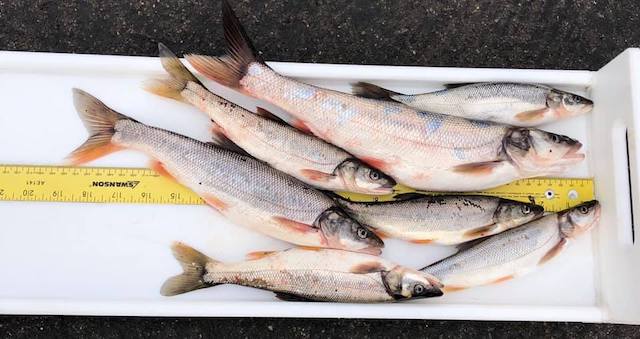forum
library
tutorial
contact

Pikeminnow Program Sees 'A Really Solid Year'
as Catch, Effort Increase
by Andy Walgamott
Northwest Sportsman, October 13, 2023
|
the film forum library tutorial contact |

|
Pikeminnow Program Sees 'A Really Solid Year'
by Andy Walgamott
|
Top angler brought in 10,127 pikeminnows worth $101,520
 The 2023 northern pikeminnow sport-reward season will go down as "a really solid year," and one that produced a six-figure payday for an angler for only the third time in the 30-plus-year history of the program.
The 2023 northern pikeminnow sport-reward season will go down as "a really solid year," and one that produced a six-figure payday for an angler for only the third time in the 30-plus-year history of the program.
"Harvest was very close to the 32-year average of 160,000 and effort increased by more than 10 percent," program manager Eric Winther also reports.
The May 1-September 30 fishery held on the Columbia with catch stations from Cathlamet to Vernita and the Snake from Pasco to Clarkston is meant to tamp down predation by the native species on outmigrating salmon and steelhead smolts.
The removal of 156,505 pikeminnows was a five-year high and marked a second straight increase after 2021's worst-ever haul of 89,542.
"Top station was at Boyer Park below Lower Granite Dam, although Washougal and The Dalles were not far behind," Winther adds. "Best fishing areas (based on catch per unit effort) were near Bonneville Dam, especially above the dam."
Boyer saw 26,049 turned in, Washougal 25,875 and The Dalles 22,792. Top CPUEs were Stevenson and Cascade Locks, at 34.9 and 30.6, respectively, while Washougal saw 25.4.
"The top angler caught more than 10,000 fish worth over $100,000 and second place angler caught only about 300 fish less," Winther notes.
For the record, that top angler brought in exactly 10,127 pikeminnows worth $101,520. That's the fourth highest catch and the second highest payout in the program's history, although they also follow on 2022's across-the-board increases in how much is paid for the fish -- from $5, $6 and $8 to $6, $8 and $10, based on how many anglers have turned in -- which was meant to boost lagging participation. There are also specially tagged pikeminnow worth $500.
The most ever paid out to an angler was $119,341 in 2016 for a record 14,019 pikeminnows, including 12 tagged fish. In 2015, $100,453 was paid to a fishermen who turned in 12,053, while in 2017 a participant collected $83,877 for 10,227.
"We successfully deployed our Pikeminnow phone app for easier angler registering and despite some usual start-up glitches, we plan for the app to be even more angler friendly in 2024," Winther also states. "All in all, a really solid year punctuated by some exceptionally good fishing during several windows of opportunity in multiple areas."
The 2023 season will also be notable for participants' 80 percent increase in walleye catch on the Snake River near Lower Granite, symbolic of a growing population of another salmon smolt eater that is "alarming" Idaho fishery managers, as well as Washington's. A late August article in the Lewiston Tribune was headlined "Fisheries managers mull walleye bounty," but it also noted Oregon was hesitant to join an effort unless "Idaho, Washington and the [Nez Perce] tribe can show there is a conservation benefit to removing walleye."
"Salmon and steelhead did not evolve with these non-native predators and can be especially vulnerable to predation," stated IDFG in a blog this summer urging anglers not to release walleye, which they say consume smolts at similar rates to pikeminnow, especially those subeater-sized 10- to 16-inchers.
(For his part, Winther notes that he's also seen diet studies showing pikeminnows themselves are a favorite snack of walleye, "so it will be interesting to see how/if that affects pikeminnow anglers in the future.")
No money is paid out for walleye, but preliminary figures show 2,085 were reported to the pikeminnow program's Boyer Park Station this year, up from 1,152 in 2022 -- and just 96 in 2021.
Overall sport-reward programparticipation this year was 11,954, the most in three years and nearly 1,400 more than last year's lowest-ever effort of 10,561.
Funding comes from the Bonneville Power Administration, which sells electricity generated by the Army Corps of Engineers' dams on the Columbia and Snake. Damming the rivers created a more favorable environment for pikeminnow (and other species) to prey on young salmonids in the relatively slow-moving and often warmer pools.
Next up for Winther is to analyze 2023 season data and compile the annual report. Meanwhile, participants have until November 15 to submit payment vouchers.
Related Pages:
Wanted: Pikeminnow that Prey on Salmon, Steelhead by Associated Press, KTVB, 5/9/7
learn more on topics covered in the film
see the video
read the script
learn the songs
discussion forum
